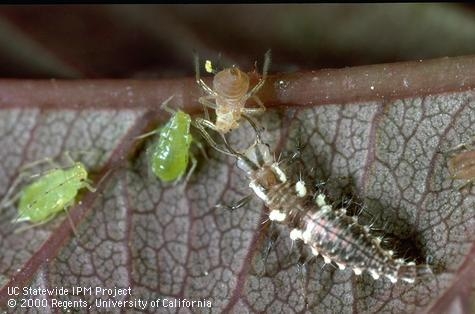
Beneficial insects are those that improve pollination, gobble up or lay their eggs inside insect pests, or speed up decomposition. Common beneficial insects include honeybees, minute pirate bugs, syrphid flies, assassin bugs, tachnid flies, big-eyed bugs, lacewings, native bees, parasitic wasps, butterflies and damsel bugs. Lady beetles are one of the most popular beneficial insects. A single lady beetle may eat 50 aphids a day, but it will fly away if its needs are not being met.
You can make your Morgan Hill yard and garden more welcoming to beneficial insects by meeting those needs with year round food, water, and shelter, using native plants. Local insects have evolved using native plants for food and shelter for thousands of years. Hedgerows and clusters of native shrubs and perennials can provide low-maintenance habitat for many beneficial insects.
To attract pollinators, try adding these plants to your landscape:
- Brandegee Sage (Salvia brandegeei)
- Borage (Borago officinalis – not native, but highly effective)
- California poppies (Eschscholzia californica)
- Coast buckwheat (Eriogonum latifolium)
- Great Valley gumweed (Grindelia camporum)
- Tansy (Phacelia tanacetifolia)
- Wild Liliac (Ceanothus sp.)
The following native plants make excellent habitats for pest-eating insects (with buckwheat being the favorite of most beneficial insects):
- Blue wildrye (Elymus glaucus)
- California buckwheat (Eriogonum fasciculatum foliolosum)
- California coffeeberry (Rhamnus californica tomentella)
- California lilac (Ceanothus griseus)
- California onion grass (Melica californica)
- Coyote brush (Baccharis pilularis)
- Creeping wildrye (Leymus triticoides)
- Elderberry (Sambucus mexicana)
- Manzanita (Arctostaphylos sp.)
- Nodding needlegrass (N. cernua)
- One-sided bluegrass (Poa secunda)
- Purple needlegrass (Nassella pulchra)
- Toyon (Heteromeles arbutifolia)
Providing shelter for beneficial insects often means nothing more than providing a source of water and avoiding the use of broad-spectrum pesticides and bug zappers. Pesticides and bug zappers often kill beneficial insects. According to research published in science research journal PLOS One, insect hotels may or may not be effective, but they might help and they do make nice garden art. Since each insect species has its own habitat needs, creating different levels within a landscape, using trees, shrubs, perennial beds, and low-growing ground cover can provide the widest variety of shelter possibilities. Shelter can also take the form of bare patches of soil or sand for ground dwelling solitary bees.
Plant a variety of colors and shapes, making sure that food and habitat are available year-round whenever possible. Some beneficial insects love round chive blooms, while others prefer the flat landing area provided by cilantro. Salvia's spikey blooms and daisy-like sunflowers fill out the range of flower shapes. Many delicious herbs, such as rosemary, oregano, dill, and thyme are irresistible to beneficial insects.
The rainy days of November are an excellent time to draw or list existing plants, noting when they bloom, their color and blossom shape, and which beneficial insects they attract. The next step is to see what is still needed for the biggest impact. If your Morgan Hill garden has specific pests that attack regularly, you can install plants to attract beneficial insects known to feed on those pests.
For more information, visit Master Gardeners or call 408-282-3105, Monday through Friday, 9:30 a.m. to 12:30 p.m.
by UC Master Gardener Kate Russell
This article first appeared in the November 9 issue of the Morgan Hill Life.

